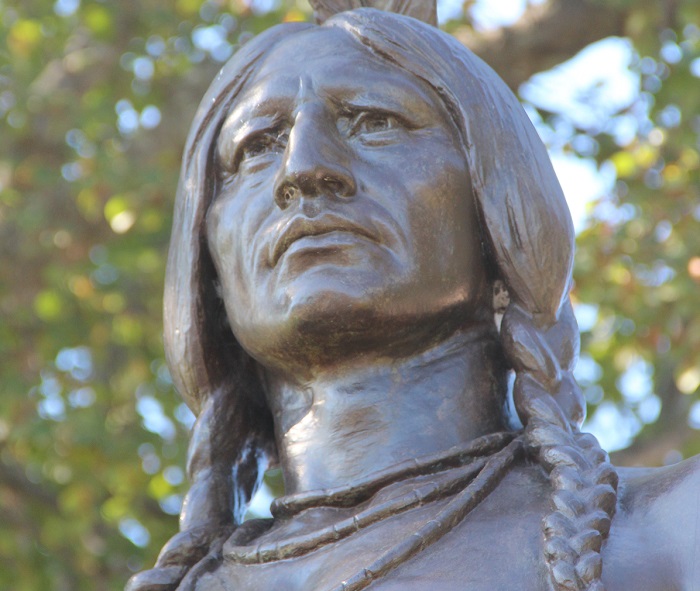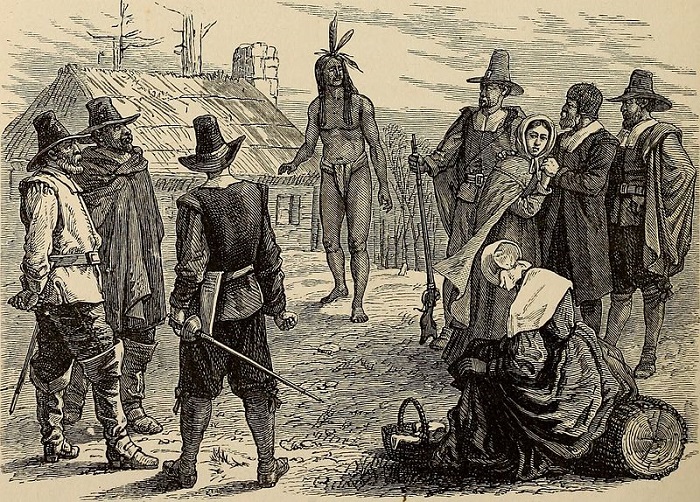Thanksgiving commemorates one of the most durable early alliances crafted between indigenous American tribes and European settlers. Intertribal Chief Massasoit of the Wampanoag (Pokanoket) and Governor William Bradford of the Plymouth settlers adopted this historic peace treaty in 1621. By 1620, Massasoit’s confederation was imperiled by the larger and stronger Narragansett tribe; and had suffered significant losses from an unknown disease (almost certainly Smallpox). At the same time, the Plymouth colony had lost half of their members due to starvation and new diseases, as well. Both consulted their religious advisors, interpreting the deaths as a supernatural punishment, but neither saw clear spiritual signs as to a course of action.

Massasoit sent Samoset to feel out the intentions of the pilgrims, and later Squanto (probably a nickname for Tisquantum), a Patuxet who spoke fluent English after he had been kidnapped and taken to Spain in 1914, subsequently escaping to England and finally returning to his homeland. Negotiating through Squanto, Massasoit and Bradford adopted their formal treaty on March 22, 1621. It was a peace that would last more than fifty years after Squanto’s death.
Their alliance offered substantial protection for the Wampanoag from the much stronger Narragansetts; giving them access to firearms and allies and giving Massasoit’s confederation relative regional safety. It also imbued the Plymouth settlers with the skills they desperately needed to farm America-native crops, particularly corn, and hunt native eels. All contemporary sources credit this alliance with the Plymouth colony’s survival in the face of impending starvation. Later in the year, the signatories participated in the first Thanksgiving feast. The Wampanoag brought deer for the meal, which also included turkeys, geese, ducks, eels, shellfish, cornbread, succotash, squash, berries, wild plums, and maple sugar.

The treaty was more than a non-aggression pact. Late in 1621, the Plymouth colonists heard a rumor that Massasoit himself had been kidnapped by Corbitant, an upstart Wampanoag leader; and a war party under Miles Standish immediately marched to rescue (or at least avenge) him. Massasoit had actually evaded Corbitant, but Squanto was among the captives, who Standish rescued. In the winter of 1623, Massasoit fell ill, and the pilgrims sent their doctors to treat him. Even the governor at the time, Edward Winslow, personally brought him broth, until he recovered. Later, the Wampanoag gave the pilgrims forewarning of a war party of Massachusett warriors who were advancing to destroy the Plymouth colony.
Eventually, after the deaths of the long-lived Massasoit and Bradford, subsequent conflicts, abuses, tensions, and disease caused the peace to deteriorate, and the former allies went to war. Today, only about 4,500 Wampanoag descendants are left, most of whom live on Martha’s Vineyard.
Given the extended period of cooperation, the language of the Wampanoag is particularly well preserved; it is an offshoot of Algonquian. Although no indigenous society had a written language before European contact, several began to develop. By the 1640s, documents, mostly religious in nature, were being published by European settlers in Wampanoag Algonquian for native consumption, eventually leading to the first native language Bible (translated and printed in 1663). During the time of the peace treaty, Wampanoag peoples began to write their own internal civil documents, including wills and deeds. These documents, some of the earliest created by indigenous peoples, have been instrumental in preserving their dialect and culture.
The library offers many resources for the study of indigenous peoples – from tribes and their customs, to peace and war, to friendships and betrayals. Databases like Early Encounters in North America, American Indian History Online, Sabin Americana: History of the Americas, 1500–1926, and Colonial America offer articles, essays, primary sources, maps, and more. Major reference works like Handbook of North American Indians include in-depth explorations of every tribe, by region.
Books that explore the Wampanoag, Massasoit, the first Thanksgiving, and indigenous culture at the beginning of European contact include Good News from New England by Edward Winslow (Scholarly Edition), The Columbia Guide to American Indians of the Northeast by Kathleen Bragdon, Ninigret, Sachem of the Niantics and Narragansetts: Diplomacy, War, and the Balance of Power in Seventeenth-Century New England and Indian Country by Julie A. Fisher, Massasoit of the Wampanoags by Alvin G. Weeks, Paper Sovereigns: Anglo-Native Treaties and the Law of Nations, 164-1664 by Jeffrey Glover, On Plymouth Rock by Samuel A. Drake, and Subjects unto the Same King: Indians, English, and the Contest for Authority in Colonial New England by Jenny Hale Pulsipher.

If you need help finding more information, don’t hesitate to Ask Us at iueref@iue.edu or click this button:



